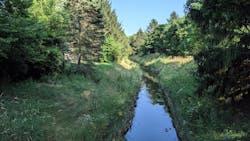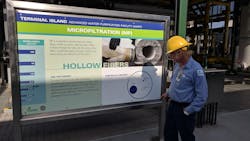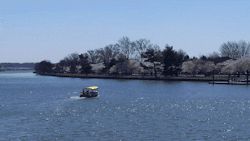Water is Life: Conserve, Recycle & Innovate
About the author:
Madan Arora Ph.D., P.E., BCEE is a technical director at Parsons. Arora can be reached at [email protected].
Why Water is Life
Did you know that water is needed in almost everything we use, we do, and we eat? Table 1 shows a summary of how much water we use every day for food and products we use in our homes and daily lives without even thinking for a moment how much water is needed to make these products.
Did you also know that the human body contains 70 to 75% of water by weight? So a person weighing 160 pounds contains about 115 pounds of water. This is simply mind boggling. To put it mildly, we cannot live without water — a lot of water.
|
Item |
Quantity of Water Needed |
| Order of Fries | 6 gallons |
| Can of Peaches | 9 gallons |
| 1 Liter Bottle of Soda | 3 gallons |
| Glass of Milk | 65 gallons |
| Hamburger | 1,300 gallons |
| New Car | 40,000 gallons |
| Cotton Jeans | 1,800 gallons |
| 1 Wheat Bun | 20 gallons |
| 1 Almond | 1 gallon |
| Water Consumed in Food Per Capita Per Year | 2,000 to 3,000 gallons |
| 1 Cotton Shirt | 700 gallons |
| 1 Pound of Plastic | 25 gallons |
| 1 Pound of Lettuce | 15 gallons |
Water is life.
So philosophically, not buying and consuming too much – clothes, furniture, cars, toys, i-phones, big luxury homes, unneeded appliances — will save a lot of water. Recycle and donate these to charities so that, in the big picture, water consumption is reduced. Overconsumption reduces our supplies of water.
It is a moral imperative that we, as a society, should discard the culture of excessive consumerism and waste since it needlessly consumes large quantities of water which is worth conserving.
This article presents three important ways of water management:
- The conservation of water;
- Water reuse and recycling; and
- Water and wastewater treatment innovation.
The Conservation of Water
Water conservation is an important yet practical and simple-to-implement way to ensure that our water supplies last longer at home, in our neighborhoods, in our cities and villages, in our states and countries and by extension on our planet as a whole.
Below are many practical ways to conserve water that we can take in our everyday life in a handful of categories.
Establish Good Habits With Daily Chores
- Teach your kids how to conserve water and help them do it. Rewards are a great incentive.
- When washing clothes, make sure to wash full loads of laundry. This same rule applies when using the dishwasher, keep it full.
- Match the water fill to the appropriate size of laundry that you are doing.
- Use the broom instead of hose to clean your driveways or sidewalks.
- Teach your kids to turn the faucets off tightly after each use.
Think About Washing Efficiencies
- When washing your dishes (without the dishwasher) do not leave the water running to rinse.
- Try to use fewer plates and cups to reduce the amount of water needed for washing.
- Fill the sink with soapy water in the sink when washing dishes by hand. Quickly rinse under a slow-moving stream from the faucet.
- Use energy-efficient washing machine. It saves up to 18 gallons of water per load.
- Use the commercial car wash to wash your vehicle. A lot of water is wasted doing it at home.
Lawn & Yard Maintenance Water Use
- Plant your garden in the spring since water requirement is reduced.
- Minimize the amount of time spent watering the lawn. Ensure you are watering it only when needed and do not overwater it.
- When watering the lawn ensure that the sprinkler system is set the right way so you are not watering the gutters and driveways. Make every drop count.
- Harvest rainwater if allowed in your area. Store it and use it when needed.
- Use brooms or other tools to clean gutters instead of the water hose.
- Use a layer of mulch around your plants so they retain moisture for a longer time period.
- Check your hoses and pipes for leaks, cracks, and other damage.
- If you have a small lawn, try to water it by hand rather than using sprinklers. This way you have more control over the amount of water used.
- Install covers on pools to avoid loss of water by evaporation.
- Water your lawn during early parts of the day.
Hygiene & Food Efficiencies
- Turn the water off when brushing your teeth or washing your hair.
- Do not use water to defrost foods. Although many people use this method, it requires a lot of water to do so.
- Take shorter showers.
- Stop using extra water when you flush by avoiding placing anything in the toilet. This includes tissue and cigarette butts.
- Use the right size pans when cooking.
- Don’t let water go down the drain while you are waiting for the temperature to adjust when taking a bath.
Appliance Water Use
- Purchase water-efficient products and appliances for your home. This includes dishwashers, sink systems, bathtubs and more.
- Check for leaks. This includes the toilet and the sinks in the home.
- Recycle water used in water fountains and other water decorations.
- Consider purchasing a dual-flush toilet. These technology-savvy toilets are great to promote water conservation.
- Install water saving devices such as low-flow shower heads on all showers and faucet aerators on all faucets to reduce water use.
- Read your house water readings at regular intervals when no water is being used and check for hidden water leaks.
- Don’t use your toilet as a trash can. Every time you flush your toilet, you use up to 9 to 12 liters of water.
Water Reuse & Recycling Treatment Stages
Did you know that wastewater is 99.9 to 99.95% water? It is only the remaining 0.05 to 0.1% (about 500 to 1000 mg/L) that is composed of impurities originating from industries or from human consumption of water. Wastewater treatment and recycling, therefore, involves removing only these impurities. Why then should we not reuse and recycle water?
The population on our planet is projected to increase to more than 9 billion from the current 7.5 billion by the year 2040. In addition, standards of living are continually increasing all over the globe, which are further stressing our water resources. However, water quantities available for use are constant and always have been since the dawn of time. Water recycling is a resource which therefore must be tapped to meet the continually growing demand of water. This serves as another reason why we should reuse and recycle water.
There are five stages or levels of wastewater treatment, some or all of them are necessary before water can be reused and recycled. How many stages should be employed before reuse depends upon the type of intended reuse. The purpose and level of treatment in all cases is the protection of public health. For example, if the water is going to be reused for growing alfalfa intended for animal feed, the requirements will be less stringent than if it is to be used to grow edible crops like tomatoes and lettuce. Similarly, if the intended use is for irrigation of golf courses at night time, the requirements would be less stringent than if the intended use is for irrigation of school playgrounds used by children. Reuse for drinking purposes — direct potable reuse (DPR) or indirect potable reuse (IPR) applications — would require the highest quality of recycled water and all five stages of treatment. In addition very aggressive monitoring, redundancy and reliability in design and operation would be required, and reuse applications in between these two extremes — of which there are numerous — will similarly require fewer stages of treatment.
These five stages of treatment (see Figure 1) schematically are:
- Preliminary treatment;
- Primary treatment;
- Secondary treatment;
- Tertiary treatment; and
- Advanced treatment.
Different stages remove different constituents from wastewaters. Preliminary treatment primarily removes grit and screenings; primary treatment removes organic and inorganic suspended matter; secondary treatment removes both suspended and dissolved organic substances mostly by biological means; tertiary treatment in most part removes particles not removed in previous stages of treatment; and the last and fifth stage removes refractory and nonbiodegradable materials, and after disinfection with high doses of disinfectants and oxidants such as ultraviolet light, ozone and hydrogen peroxide to prepare the water for many unrestricted reuse applications including DPR and IPR.
Advanced Water Treatment
Although most of us are quite familiar with the first four stages of treatment since almost all wastewater treatment plants today employ these treatment stages in some form or the other, the advanced treatment stage (AWT) is not that common. In water scarce parts of the country — such as California — AWT has been provided by a few large water agencies and is being considered by many others. This opens up other avenues for water reuse such as IPR and DPR via groundwater recharge, storage in underground water aquifers, storage in large raw water reservoirs used as a source of drinking water supplies, and many others.
AWT essentially removes refractory materials, not removed in the first four stages of treatment, which are present at parts per trillion levels (ppt) in wastewater. The sources that contribute to these refractory and recalcitrant materials are industries (most often their products have proprietary formulations and contain chemicals, which do not have to be disclosed and therefore are not disclosed by the industries), personal care products used in homes such as fragrances and others, medicines and drugs, antibiotics, pesticides, and various pharmaceutical compounds, to name a few.
These materials are believed to be carcinogens and endocrine disruptors and must be removed for IPR and DPR applications per regulations promulgated by many states and local jurisdictions to protect public health. If not removed, they could interfere with the body's endocrine system with long enough exposure, and can produce adverse developmental, reproductive, neurological and immune effects in humans and wildlife.
With new analytical methods now available, these chemicals — even though present in parts per billion and parts per trillion concentrations — can be easily measured. Their long-term effects on human health are not always fully known, but are of concern in reuse of water for IPR and DPR.
Each stage of treatment produces a waste stream (screenings, grit, biosolids or sludge, etc.) which must be hauled away, or treated to produce beneficial materials such as soil conditioners, compost and some form of aggregate with potential reuse applications in roads, land reclamation, and others. Once again, there are state and federal requirements and standards that govern these uses with the sole objective of protection of public health.
In addition, anaerobic digestion of biosolids can produce up to 60 kW of electricity per 1 mgd of wastewater flow. New processes are being developed to increase this further so that wastewater treatment plants are close to being energy neutral (and some already are achieving that). Treatment of these waste streams is beyond the scope of this paper.
Water Recycling Applications
Table 2 below presents a summary of potential reuse and recycling applications and general water quality requirements for these uses. This table is meant to be very general because each state and local jurisdiction may have different requirements that must be determined before a reuse project is planned and implemented.
Please note the method of applying water for irrigation-spray versus subsurface drip, for example- can make a difference in the level of treatment required. The public exposure to spray irrigation systems is much higher than subsurface drip irrigation and thus may require higher levels of treatment and associated application restrictions.
Use the following key to identify the treatment guidelines in the second column of Table 2 below.
- TFD = Tertiary filtered and well disinfected effluent; Total Coliform < 2.2/100 mL
- DSE = Disinfected secondary effluent, Total Coliform < 23/100 mL
- WDSE = Well disinfected secondary effluent; Total Coliform < 2.2/100 mL
- AWT = Advanced Water Treatment incorporating removal of enteric virus reduction equal to at least 12 log and, Giardia at least 10 log etc. (total between all five treatment stages)
| Application | General Guidelines for Recycling |
|
Landscape irrigation of public areas without restriction |
TFD |
|
Landscape irrigation of areas with restricted public access such as highway landscaping |
DSE |
|
Nurseries, Christmas tree farms, tree farms, and sod farms |
DSE |
|
Food crops |
TFD |
|
Food crops that undergo commercial, pathogen destroying processing before consumption |
DSE |
|
Pasture and fodder for animals, fiber (cotton) and seed crops not eaten by humans |
DSE |
|
Orchards and vineyards not bearing food crops during irrigation |
DSE |
|
Supply for non-restricted recreational impoundments |
TFD |
|
Supply for restricted recreational impoundments, fish hatcheries |
WDSE |
|
Toilet and urinal flushing in commercial buildings |
TFD |
|
Commercial and public laundries for clothes washing |
TFD |
|
Cooling tower make-up |
TFD |
|
Industrial process water (potential worker exposure) • Boiler feed water • Fire fighting • Fire fighting by dumping from aircraft • Water jetting for backfill consolidation around potable water lines • Water jetting for backfill consolidation around other than portable water lines • Washing aggregate and making concrete • Dust control and fill moisture control • Decorative fountains • Snowmaking |
TFD DSE TDF DSE TDF DSE DSE DES TDF TDF AWT |
|
Industrial process water (no worker exposure) • Boiler feed water • Fire fighting • Fire fighting by dumping from aircraft • Water jetting for backfill consolidation around potable water lines • Water jetting for backfill consolidation around other than portable water lines • Washing aggregate and making concrete • Dust control and fill moisture control • Decorative fountains • Snowmaking |
DSE DSE TDF DSE TDF DSE DSE DSE TDF AWT |
Water & Wastewater Treatment Innovation
Future of wastewater treatment and water reuse seems to be limitless. In general, it will necessitate innovations in the following areas:
- Potable reuse – both direct and indirect – advances in technologies, public relations and cost optimization.
- New technologies for nitrogen and phosphorus removal, which are of concern in reuse for lake replenishment and reservoirs, and discharge into sensitive water bodies.
- Optimization and development of new membrane processes to replace secondary clarifiers and tertiary filters to ultimately reduce capital costs and energy consumption.
- New and cost-effective processes for removal of refractory and recalcitrant compounds, including studies to determine their impact on human health and wildlife.
- New technologies for treatment of residuals and biosolids resulting from treatment of wastewaters aimed at nutrient recovery (nitrogen and phosphorus), enhanced energy recovery from digestion, and near complete recycling and reuse of biosolids.
- Reducing energy and carbon footprint of existing and new technologies to enhance sustainability and reduce the formation of greenhouse gases and impact on global warming.
- Decentralized treatment facilities for optimal water reuse and recycling in areas close to points of reuse.
- Public education to enhance acceptance of recycled water for various applications including potable reuse.
- Political will to spend resources on studying the above issues and the implementation of reuse projects.
- Build more sea water desalination plants using innovative membranes with higher water recovery and lower pressure.
The future wastewater treatment plants will be resource recovery plants, not just in euphemism, but in actuality.
Water is Life
Water management for our growing population and water needs is a tall order. But as water sector engineers and planners have demonstrated repeatedly over the years, this is a task that is not only important but achievable. Remember It will involve conservation, recycling and innovation. We have come a long way from septic tanks to modern-day plants employing complex technologies, so moving forward is certainly easier than the journey of the past.



